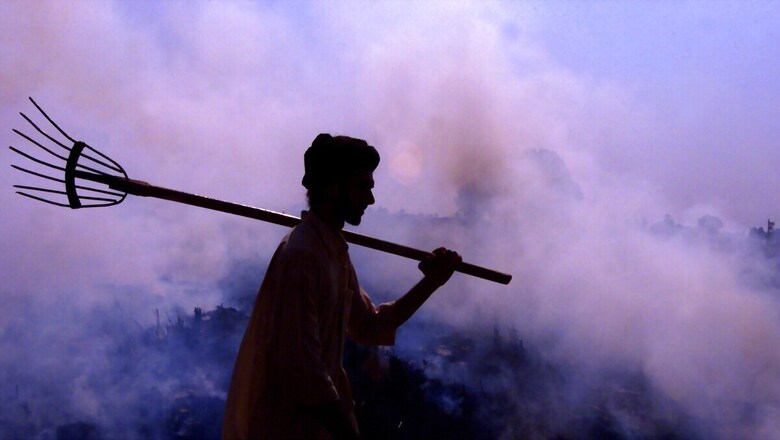
views
Greenhouse gas emissions from agricultural residue burning are estimated to have shot up by 75% over the last decade, according to a new study that analysed the satellite data of all states from 2011 to 2020.
The study was led by researchers from the Indian Institute of Science Education and Research (IISER), Bhopal, along with international collaborators. The team used a remote-sensing based approach to monitor burned agricultural area across all states to quantify the actual residues burned and then estimate the seasonal emissions from it.
The findings published in the peer-reviewed scientific journal Science of the Total Environment provide a comprehensive seasonal analysis of stubble burning in India, including burned area, dry matter burned, and gaseous emissions for seven major crops from 2011 to 2020.
PUNJAB, MADHYA PRADESH TOP EMITTERS
According to the estimate, there has been a 75% increase in emission of Carbon Monoxide (CO) and greenhouse gases – Carbon Dioxide, Methane and Nitrous Oxide – over the last decade.
Carbon Dioxide (CO2) emissions increased from approximately 19,340 Gigagram per year (Gg/year) in 2011 to approximately 33,834 Gg/yr in 2020.
Most emissions occurred during the end of the Kharif season (June-November), caused by burning of paddy stubble, followed by Rabi (November-April). More than half of these emission events occurred in north-west India, and Punjab remained the top emitter with the highest burning activity, with nearly 27% (2.0 million hectares) of its total cultivated area burned in 2020.
There was a 21% increase in burnt agricultural area in the states of the Indo-Gangetic Plains, mainly Punjab and Haryana, during this period.
However, the study found that crop burning has surged exponentially in non-Indo-Gangetic Plains (IGP) states in recent years. Interestingly, Madhya Pradesh was found to be the second-largest emitter, accounting for 30% of the total burned area across India in 2020, as per the study.
NO END TO STUBBLE BURNING
Despite being banned by the National Green Tribunal (NGT), stubble burning is still carried out in Rajasthan, Uttar Pradesh, Haryana, and Punjab every year, wherein farmers set fire to large swathes of their harvested land to clear them for the next crop.
“While there was an initial decrease in burning in 2014-2015 due to policy implementation, a surge occurred in 2016, highlighting the need for more effective and sustainable policies,” said lead author Monish Deshpande, a research scholar at IISER Bhopal.
Stubble burning remains the fourth largest contributor to biomass burning emissions globally. In fact, around 87.0 million tonnes (Mt) of crop residue is burned annually in India. It is also a major problem that worsens the winter smog, and raises the risk of respiratory infections in the region.
The period under study – 2011 to 2020 – is also the time when India increased its total food grain production by about 36%. There were multiple crop cycles, and technological advancements led most farmers to shift to mechanised harvesting and absence of cost-effective residue removal solutions worsened the problem.
“By examining temporal trends in our data, we also find that several policies that have been promoted to reduce residue burning have been ineffective and have not resulted in a reduction of stubble burning across the Indo-Gangetic plains,” said the team.
RICE, WHEAT BIGGEST CONTRIBUTOR
The team studied the data of as many as seven crops – wheat, rice, sugarcane, maize, jute, groundnut and cotton — whose residues are mostly burnt. It found that stubble burning of rice, wheat, and maize crops accounted for 97% of India’s agricultural burning emissions, with rice being the largest contributor at 55%, followed by wheat (34 %) and maize (8 %) to emissions. However, emissions from maize have tripled since 2011.
“Crop residue burning has significant repercussions, as it releases pollutants and greenhouse gases to the atmosphere, leading to severe and adverse impacts on climate, public health, and food security. Current agricultural practices are unsustainable and adequate technology interventions are crucial,” said Assistant Professor Dr Dhanyalekshmi K Pillai, head of the Max Planck Partner Group at IISER Bhopal.
According to the team, the study also demonstrates how spectral data — light and other electromagnetic radiation — collected by space-based instruments can be used to estimate greenhouse gas emissions on a massive scale.
















Comments
0 comment